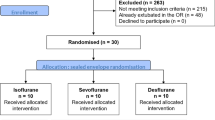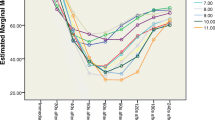Abstract
Purpose
We examined the hypothesis that 1 minimum alveolar concentration (MAC) of desflurane and sevoflurane provides different depth of anesthesia.
Methods
One hundred and twenty young (20–30 years), middle-aged (31–65 years), and elderly (66–80 years) patients were randomly allocated to receive either desflurane or sevoflurane (n = 20, each group). General anesthesia was induced with propofol 2 mg/kg bolus and remifentanil 0.25 µg/kg/min, which was stopped after tracheal intubation. Maintenance of anesthesia was started with an end-tidal concentration of desflurane or sevoflurane at age-adjusted 1 MAC and maintained for 10 min, followed by 1-min assessment of bispectral index (BIS), 95% spectral edge frequency (SEF95), and amplitude of the electroencephalogram taken at 10-s intervals.
Results
BIS and SEF95 in patients receiving 1 MAC desflurane were significantly lower than those receiving 1 MAC sevoflurane including all age groups [35 (29, 39) vs. 41 (38, 49); 12.53 (10.99, 13.95) Hz vs. 14.42 (12.99, 17.17) Hz median (25, 75 percentile), respectively, P < 0.001 for both]. Both BIS and SEF95 in young patients were lower than in middle-aged and elderly patients receiving either desflurane or sevoflurane (P < 0.001 for both). There were no differences in amplitude between patients receiving desflurane and sevoflurane.
Conclusions
BIS as well as SEF95 were lower in patients receiving 1 MAC desflurane than those receiving 1 MAC sevoflurane, suggesting that desflurane provides higher depth of anesthesia than sevoflurane at 1 MAC.


Similar content being viewed by others
Notes
Address: 5-15-21 Nakano-cho, Miyakojima-ku, Osaka 534-0027, Japan.
References
Jakobsson J. Desflurane: a clinical update of a third-generation inhaled anaesthetic. Acta Anaesthesiol Scand. 2012;56:420–32.
Weiskopf RB, Moore MA, Eger EI 2nd, Noorani M, McKay L, Chortkoff B, Hart PS, Damask M. Rapid increase in desflurane concentration is associated with greater transient cardiovascular stimulation than with rapid increase in isoflurane concentration in humans. Anesthesiology. 1994;80:1035–45.
Kim JK, Kim DK, Lee MJ. Relationship of bispectral index to minimum alveolar concentration during isoflurane, sevoflurane or desflurane anaesthesia. J Int Med Res. 2014;42:130–7.
Fassoulaki A, Kaliontzi H, Petropoulos G, Tsaroucha A. The effect of desflurane and sevoflurane on cerebral oximetry under steady-state conditions. Anesth Analg. 2006;102:1830–5.
Rampil IJ, Lockhart SH, Zwass MS, Peterson N, Yasuda N, Eger EI 2nd, Weiskopf RB, Damask MC. Clinical characteristics of desflurane in surgical patients: minimum alveolar concentration. Anesthesiology. 1991;74:429–33.
Gold MI, Abello D, Herrington C. Minimum alveolar concentration of desflurane in patients older than 65 yr. Anesthesiology. 1993;79:710–4.
Kanazawa S, Oda Y, Maeda C, Okutani R. Age-dependent decrease in desflurane concentration for maintaining bispectral index below 50. Acta Anaesthesiol Scand. 2016;60:177–82.
Oda Y, Tanaka K, Matsuura T, Hase I, Nishikawa K, Asada A. Nitrous oxide induces paradoxical electroencephalographic changes after tracheal intubation during isoflurane and sevoflurane anesthesia. Anesth Analg. 2006;102:1094–102.
Nickalls RW, Mapleson WW. Age-related iso-MAC charts for isoflurane, sevoflurane and desflurane in man. Br J Anaesth. 2003;91:170–4.
Conover WJ, Iman RL. Rank transformations as a bridge between parametric and nonparametric statistics. Am Stat. 1981;35:124–9.
Zorrilla-Vaca A, Healy RJ, Wu CL, Grant MC. Relation between bispectral index measurements of anesthetic depth and postoperative mortality: a meta-analysis of observational studies. Can J Anaesth. 2017;64:597–607.
Umamaheswara Rao GS, Ali Z, Ramamoorthy M, Patil J. Equi-MAC concentrations of halothane and isoflurane do not produce similar bispectral index values. J Neurosurg Anesthesiol. 2007;19:93–6.
Matsuura T, Oda Y, Tanaka K, Mori T, Nishikawa K, Asada A. Advance of age decreases the minimum alveolar concentrations of isoflurane and sevoflurane for maintaining bispectral index below 50. Br J Anaesth. 2009;102:331–5.
Matsuura T, Oda Y, Ikeshita K, Nishikawa K, Ito K, Asada A. Differential electroencephalographic response to tracheal intubation between young and elderly during isoflurane and sevoflurane nitrous oxide anaesthesia. Br J Anaesth. 2007;99:858–63.
Purdon PL, Pavone KJ, Akeju O, Smith AC, Sampson AL, Lee J, Zhou DW, Solt K, Brown EN. The ageing brain: age-dependent changes in the electroencephalogram during propofol and sevoflurane general anaesthesia. Br J Anaesth. 2015;115(Suppl 1):i46–57.
McGinnis SM, Brickhouse M, Pascual B, Dickerson BC. Age-related changes in the thickness of cortical zones in humans. Brain Topogr. 2011;24:279–91.
Rice JK, Rorden C, Little JS, Parra LC. Subject position affects EEG magnitudes. Neuroimage. 2013;64:476–84.
Hagihira S. Changes in the electroencephalogram during anaesthesia and their physiological basis. Br J Anaesth. 2015;115(Suppl 1):i27–31.
Rampil IJ, Lockhart SH, Eger EI 2nd, Yasuda N, Weiskopf RB, Cahalan MK. The electroencephalographic effects of desflurane in humans. Anesthesiology. 1991;74:434–9.
Pilge S, Jordan D, Kreuzer M, Kochs EF, Schneider G. Burst suppression-MAC and burst suppression-CP50 as measures of cerebral effects of anaesthetics. Br J Anaesth. 2014;112:1067–74.
Doenicke AW, Roizen MF, Rau J, O’Connor M, Kugler J, Klotz U, Babl J. Pharmacokinetics and pharmacodynamics of propofol in a new solvent. Anesth Analg. 1997;85:1399–403.
Kazama T, Ikeda K, Morita K, Kikura M, Doi M, Ikeda T, Kurita T, Nakajima Y. Comparison of the effect-site k(eO)s of propofol for blood pressure and EEG bispectral index in elderly and younger patients. Anesthesiology. 1999;90:1517–27.
Purdon PL, Sampson A, Pavone KJ, Brown EN. Clinical electroencephalography for anesthesiologists: part I: background and basic signatures. Anesthesiology. 2015;123:937–60.
Acknowledgements
This study was covered by departmental funding only.
Author information
Authors and Affiliations
Corresponding author
Ethics declarations
Conflict of interest
The authors have no conflicts of interest.
About this article
Cite this article
Kanazawa, S., Oda, Y., Maeda, C. et al. Electroencephalographic effect of age-adjusted 1 MAC desflurane and sevoflurane in young, middle-aged, and elderly patients. J Anesth 31, 744–750 (2017). https://doi.org/10.1007/s00540-017-2391-6
Received:
Accepted:
Published:
Issue Date:
DOI: https://doi.org/10.1007/s00540-017-2391-6




